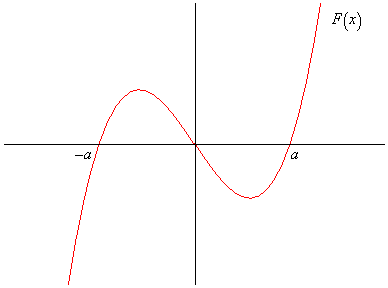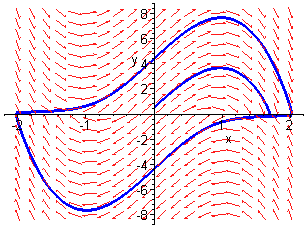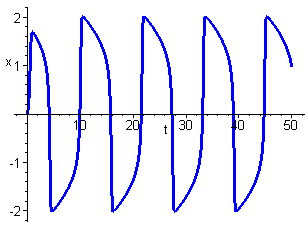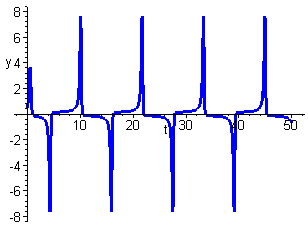![]()
A great number of mathematical models of physical systems give rise to differential equations of the type
![]()
This is known as Liénard's equation. The system is a generalization of the mass-spring-damper system
![]()
previously encountered. In Liénard's equation ![]() is
the damping term and
is
the damping term and ![]() is
the spring term. The equation can be written as the planar system
is
the spring term. The equation can be written as the planar system
![]()
Under certain conditions on f and g it can be shown that Liénard's equation has a limit cycle. This result is known as Liénard's Theorem.
Theorem - Liénard's Theorem
Suppose that f and g satisfy the conditions
(i) f and g are continuously differentiable;(ii) g is an odd function i.e.
;
(iii)
;
(iv) f is an even function i.e.
;
(v) let
and
,
, (
);
then Liénard's equation has a unique stable limit cycle surrounding
the origin.
The properties of the odd function F are indicated in the diagram below.

Use the graph to check the properties of F listed above.
![]()
where ![]() ,
has a stable limit cycle.
,
has a stable limit cycle.
This is an example of Liénard's equation with

Checking the conditions of Liénard's Theorem we find that
(i) both f and g are continuosly differentiable;(ii)
is odd and obviously
;
(iii)
and so f is even;
(iv)

The conditions are satisfied hence there exists a unique stable limit cycle surrounding the origin.
Van der Pol's equation arose from a 1926 mathematical model of an electrical
circuit containing a thermionic valve. Valves were used in early radios
and TVs. Careful observation of the damping term ![]() shows
that for small x the oscillations are negatively damped and hence
increase in amplitude. For large x the oscillations are positively
damped and hence decrease in amplitude. Intuitively somewhere between these
two extremes the damping must be zero resulting in an oscillation with
constant amplitude. This is an isolated periodic solution and hence a limit
cycle. The most interesting behaviour occurs for relatively large values
of the parameter
shows
that for small x the oscillations are negatively damped and hence
increase in amplitude. For large x the oscillations are positively
damped and hence decrease in amplitude. Intuitively somewhere between these
two extremes the damping must be zero resulting in an oscillation with
constant amplitude. This is an isolated periodic solution and hence a limit
cycle. The most interesting behaviour occurs for relatively large values
of the parameter ![]() .
.
The diagram below shows the phase portrait for the case ![]() .
.

Notice that the limit cycle is very different from one resulting from sinusoidal oscillations. This can be seen clearly in the time series plots of x and y shown below.

